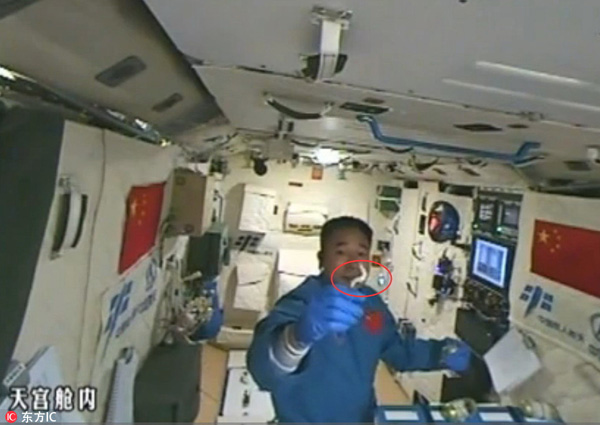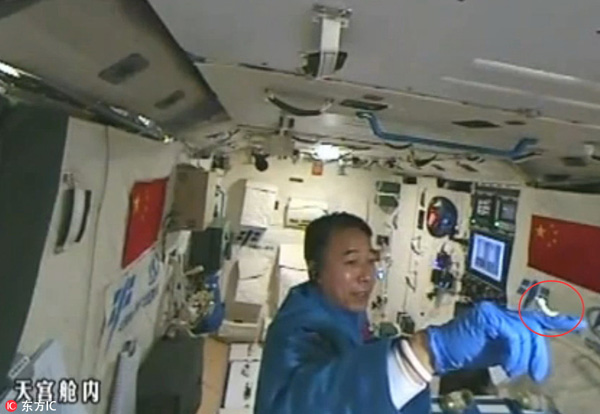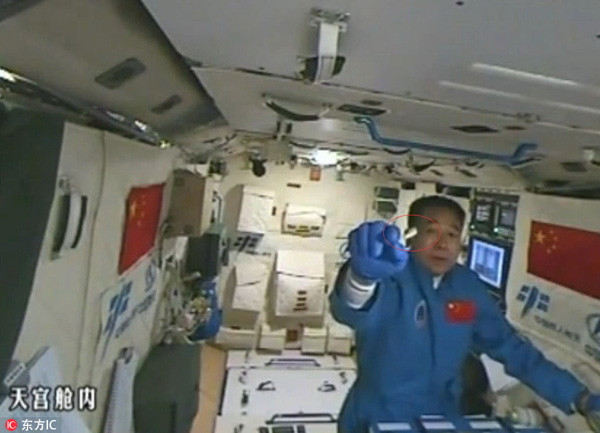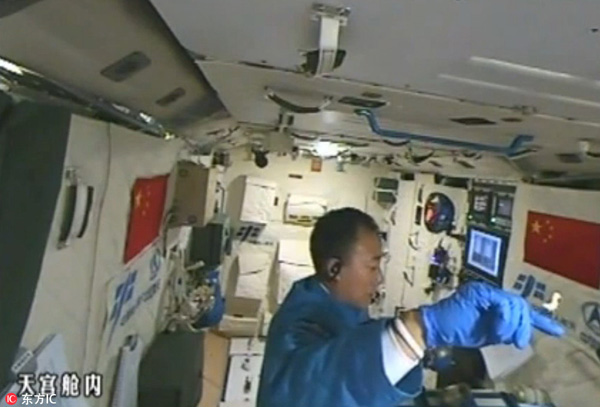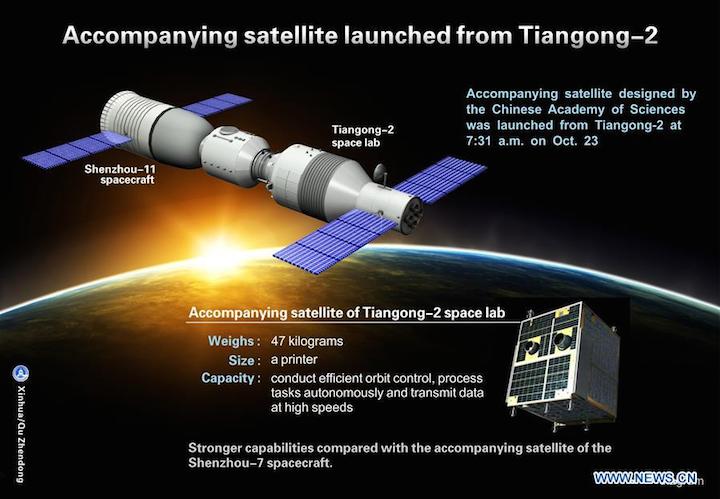
China’s Tiangong 2 space lab has a paparazzi traveling alongside it, in the form of a picture-snapping satellite that’s the size of a desktop printer.
The satellite, Banxing 2, was released from the lab over the weekend and has already captured hundreds of images of Tiangong 2 with the Shenzhou 11 spacecraft docked to it.
Testing what’s been called an orbital “selfie stick” is one of the prime objectives of the 30-day Shenzhou mission currently being conducted by Chinese astronauts Jing Haipeng and Chen Dong.
Banxing 2, which builds upon earlier experiments with inspection satellites, will fly in formation and take pictures in visible and thermal infrared wavelengths to monitor the space lab’s condition.
The 100-pound (47-kilogram), solar-powered satellite is due to use its ammonia thruster system to back away as far as 300 miles (500 kilometers) and then approach again for a close-in inspection. Banxing 2 is also expected to take pictures of Earth and monitor orbital debris.
Jing and Chen are due to leave Tiangong 2 in their Shenzhou craft and return to Earth in mid-November, capping off China’s longest crewed space mission.
Quelle: GeekWire
---
China Exclusive: China's "Little Bee" searches for strongest blasts in universe
A square-shaped probe, dubbed "Little Bee" by Chinese scientists, is searching for gamma-ray bursts, the strongest explosions in the universe.
The formal name of the probe, set atop China's first space lab Tiangong-2, is POLAR (an abbreviation of Polarimetry of Gamma-ray Bursts). The device will help open a new window in the study of gamma-ray astronomy, says Zhang Shuangnan, principal investigator on the POLAR project and a chief scientist at the High Energy Physics Institute of the Chinese Academy of Sciences.
Tiangong-2 was launched in September, and the Shenzhou-11 spacecraft last week took two astronauts to a 30-day mission in the space lab. They will prepare for the construction of a more complicated space station, conducting more than a dozen scientific experiments, most of them in cutting-edge fields of exploration.
POLAR is the only international cooperation project on Tiangong-2, involving scientists from the University of Geneva, Paul Scherrer Institute in Switzerland and Poland's Institute of Nuclear Physics.
"The 30-kg device can be regarded as a telescope, but it is different from other telescopes, as it consists of 1,600 sensitive components to detect the polarization of gamma-ray bursts. They are like the 1,600 facets in the compound eyes of bees. That's why we call it 'Little Bee' ," says Zhang.
"We hope to obtain accurate polarization information of the gamma-ray bursts for the first time ever to better understand the process of how the violent explosions happen," Zhang says.
Gamma-ray bursts are extremely energetic explosions that have been observed in distant galaxies. They are the brightest electromagnetic events known to occur in the universe. Bursts can last from ten milliseconds to several hours.
The intense radiation of most observed gamma-ray bursts is believed to be released during a supernova or hypernova as a rapidly rotating, high-mass star collapses to form a neutron star, quark star, or black hole. A subclass of bursts appear to originate from a different process: the merger of binary neutron stars.
Another aim of "Little Bee" is to determine whether gamma-ray bursts are related to gravitational waves. "If we can detect gamma-ray bursts at the same time gravitational waves happen, it will help us better understand gravitational waves. That will be very interesting," Zhang says.
He estimates that "Little Bee" can detect about 100 gamma-ray bursts during its two-year operating period.
Zhang also wants to try something outside the plan. He and his team have succeeded in locating signals from the Crab Pulsar neutron star by analyzing the data sent back by POLAR.
"This is the first time a Chinese space astronomical instrument has been used to study the remaining pulsar left by the supernova explosion recorded by the ancient Chinese nearly 1,000 years ago," Zhang says.
Quelle: Xinhua
-
Update: 27.10.2016
.
Silkworms spin cocoons in Tiangong-2

Silkworms spin cocoons in Tiangong-2
The silkworms are nestled in a specially made box. The six were selected from 4000 silkworms specially cultivated by scientists.
The astronauts have been tending to them during down time, feeding them mulberry leaves. The experiment was designed by Hong Kong middle school students.
Once returned to earth, these cocoons will be compared with others for the way they've spun their cocoons and the quality of silk in a zero-gravity environment.
Quelle: CCTV
---
|
Taikonaut Jing Haipeng shows a suit specially designed for cardiovascular research in gravity-free environment in the space lab Tiangong-2, Oct. 26, 2016. (Xinhua)
ABOARD TIANGONG-2, Today is Oct. 26, the eighth day after Shenzhou-11 docked with Tiangong-2. I am Xinhua space correspondent Jing Haipeng. Hello everyone, we meet again. Our work schedule is very full, so I fall asleep as soon as I close my eyes at night. I sleep six hours per day on average and feel quite rested. I feel in pretty good physical condition and am confident in our work and mission. Please rest assured. I saw the birthday greetings sent to me by the children the day before yesterday. I especially liked the video clip of children from home and abroad and your brilliant paintings! I was quite touched. As a matter of fact, they are not only greetings to me but also to Shenzhou-11 as well as China's manned space program. Uncle Haipeng thanks you for your concerns and greetings. I wish all children in the world can grow up healthy and happy! I also wish children can have great ambitions from a young age - to become people who dare to dream, have the courage to chase their dreams and work hard to make their dreams true. I hope you can contribute your wisdom and talent to your country. Together we will make the greatest contribution to the realization of the Chinese dream of national rejuvenation. You may notice that we are wearing suits that many people have not seen before. We wore pressure suits during the launch, but in Tiangong-2 we wear in-cabin working jumpsuits, and today we are wearing suits specially designed for cardiovascular research in gravity-free environment. It is a very special suit with many fasteners and several openings, and there are also zippers on it, as we need to take B-scan ultrasonic examinations and electrocardiograms, just like people take on Earth. It's not so convenient to wear our usual suits. With this suit, if I want to take my blood pressure, I just zip the suit. It is so easy and convenient. It is an experiment suit, so it does not look very bright but it is very useful. Of course we also have other suits, like sports suits for cycling and running, and casual suits we have not shown you yet, but later you will see. .
Taikonaut Jing Haipeng wears a suit specially designed for cardiovascular research in gravity-free environment in the space lab Tiangong-2, Oct. 26, 2016. Quelle: Xinhua |

